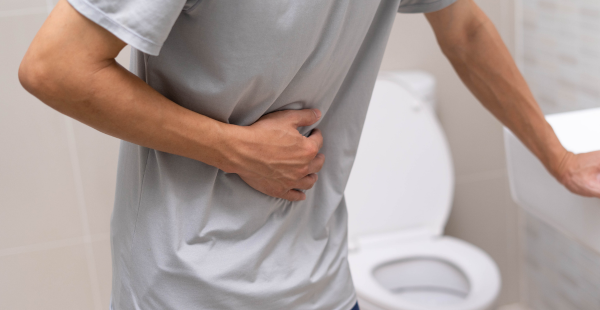Many people have spent a tropical vacation with a bad stomach bug. They might have had dysentery, a painful intestinal infection that is usually caused by bacteria or parasites. Dysentery is defined as diarrhea in which there is blood, pus, and mucous, usually accompanied by abdominal pain. It usually lasts for 3 to 7 days.

There are 2 main types of dysentery. The first type, amoebic dysentery or intestinal amoebiasis, is caused by a single-celled, microscopic parasite living in the large bowel. The second type, bacillary dysentery, is caused by invasive bacteria. Both kinds of dysentery occur mostly in hot countries. Poor hygiene and sanitation increase the risk of dysentery by spreading the parasite or bacteria that cause it through food or water contaminated from infected human feces.
Dysentery can have a number of causes. Bacterial infections are by far the most common causes of dysentery. These infections include Shigella, Campylobacter, E. coli, and Salmonella species of bacteria. The frequency of each pathogen varies considerably in different regions of the world. Dysentery is rarely caused by chemical irritants or by intestinal worms.
The Shigella and Campylobacter bacteria that cause bacillary dysentery are found all over the world. They penetrate the lining of the intestine, causing swelling, ulcerations, and severe diarrhea containing blood and pus. Both infections are spread by ingestion of food or water contaminated with infected feces. If people live or travel in an area where poverty or overcrowding may interfere with good hygiene and sanitation, they are at risk of being exposed to invasive bacteria. Young children (ages 1 to 5) living in poverty are most likely to contract shigellosis, campylobacteriosis, or salmonellosis. If one person has bacillary dysentery, others at their home, daycare, school, or nursing home are at risk of infection from close contact with the infected individual.
Intestinal amoebiasis is caused by a protozoan parasite, Entamoeba histolytica. The amoeba can exist for long periods of time in the large bowel (colon). In the vast majority of cases, amoebiasis causes no symptoms – only 10% of infected individuals become ill. It is uncommon except in developing countries in the world’s tropical zones, where it is very prevalent. People can become infected after ingesting water or food contaminated with somebody’s excreted parasites. People are at high risk of acquiring the parasite through food and water if the water for household use isn’t separated from wastewater. The parasites can also enter through the mouth when hands are washed in contaminated water. If people neglect to wash properly before preparing food, the food may become contaminated. Fruits and vegetables can be contaminated if washed in polluted water or grown in soil fertilized by human waste.
Having sex that involves anal contact may spread amoebic and bacillary dysentery. This is especially true if the sex included direct anal-oral contact, or oral contact with an object (e.g., fingers) that touched or was in the anus of an infected person.
Antiparasitic medications such as metronidazole* and paromomycin, are commonly used to treat dysentery caused by amoebiasis. Sometimes antibiotics like ciprofloxacin, levofloxacin, or azithromycin are used to treat the organisms causing bacillary dysentery. People who still have diarrhea symptoms after 2 days of treatment should consult with their doctor, as you may need to try something else.
If you travel, you should carry a one- to three-day self-treatment antibiotic regimen such as ciprofloxacin and use it in the case of sudden moderate-to-severe diarrheal illness. Bismuth subsalicylate (Pepto-Bismol®) taken preventatively can also be helpful for some travellers. In addition, use the antidiarrheal medication loperamide to slow the bowel and prevent dehydration. It is important to use antidiarrheal medications only until you can seek medical attention or to help you return home following a vacation. If you have dysentery caused by bacteria or parasite, you will want your body to expel the "bug." Consult your doctor if your child under 2 years of age has dysentery.
It is most important to replace the fluids lost from diarrhea. In mild cases, soft drinks, juices, and bottled water will be enough. More severe diarrhea should be treated with solutions that contain electrolytes such as potassium, salt, and sucrose. For severe diarrhea, commercial oral rehydration solutions are usually needed. These solutions are available in packets for easy travel. People should try to consume enough fluids so that clear-to-light yellow urine is produced every 3 to 4 hours. While affected with dysentery, it is better to stick to a bland diet (bananas, rice, soda crackers, applesauce, toast) and avoid milk products.
Dysentery can be prevented to some extent by practising careful personal hygiene.
People who travel to or live in areas with high rates of dysentery should follow the following advice:
All material copyright MediResource Inc. 1996 – 2025. Terms and conditions of use. The contents herein are for informational purposes only. Always seek the advice of your physician or other qualified health provider with any questions you may have regarding a medical condition. Source: www.medbroadcast.com/condition/getcondition/Dysentery
Pharmasave uses cookies to provide a personalized experience, analyze traffic, improve site performance, and provide social media features. By using our site, you agree to our privacy policy.